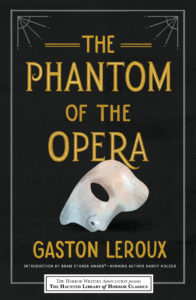It’s been a big year for looking back, with the establishment of the Paperbacks from Hell imprint, Looking forward to 2020, it appears that it will be a big year for looking even further back. The publication of several books of ghost and Gothic tales in 2019 looks like it was the beginnings of a return to the classics of the genre. 2020 will bring the first volume of HWA’s Haunted Library series that will be published in conjunction with Poisoned Pen Press, The Phantom of the Opera by Gaston Leroux. In addition, Crystal Lake has just announced that they’ll be publishing Crystal Classics, dark tales from the late 19th and early 20th century, with occasional titles that “challenge” a classic title, and the covers look lovely. Their December newsletter says the first three of these are out in paperback and will also be available as ebooks: they are The Great God Pan by Arthur Machen, with an introduction by William Meikle; Dagon Rising, a “challenge” to Lovecraft by William Meikle; and The Willows by Algernon Blackwood, with an introduction by Jasper Bark. I’ve been watching over the past several years now as some of the older or lesser-known writers are starting to be introduced to readers who may never have encountered them before, and I think we’ll continue to see this appreciation of writers from earlier times. Given the publication of books like Monster, She Wrote this year, which set a focus on lesser-known women writers (or women writers whose supernatural work was lesser-known) I think we can be sure that there will be more to uncover and appreciate! Of course, time, and literature, and our fears, move on forward, and I think we’ll see more diversity among contemporary writers in 2020 as well, if what I’m already seeing is any indication. It’s an exciting time to be a writer, publisher, librarian, researcher, and reader, and I can’t wait to see what directions the genre goes in next.








Follow Us!